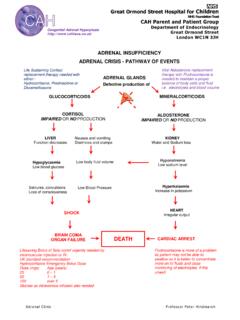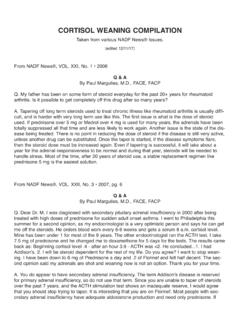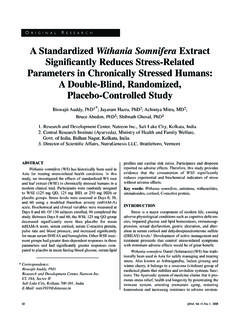Transcription of 24 HOUR PROFILE ASSESSING CORTISOL REPLACEMENT …
1 Professor Peter Hindmarsh Professor of Paediatric Endocrinology Divisional Clinical Director for Paediatrics and Adolescents at UCLH "The ideas expressed are independent of the authors' affiliations. Data provided is from current literature and should always be discussed with your endocrinologist first" THE VALUE OF 24 hour PROFILES IN ASSESSING CORTISOL REPLACEMENT IN ADDISON S By Professor Peter Hindmarsh and Kathy Geertsma CORTISOL is produced in the body by the adrenal glands and the levels in the blood vary during the day.
2 This production is called the Circadian Rhythm of CORTISOL . Values are high in the morning and early afternoon and low in the evening. You might like to think of CORTISOL therefore as a get up and go hormone. This pattern can be seen in Figure 1 which shows the CORTISOL levels of someone with a normal production over a 24 hour period. It is important to realise that not everyone has the same amount of CORTISOL in the blood but the production pattern known as the circadian rhythm is the same, except the level of CORTISOL drops lower earlier in the evening in children. Figure: 1 The body s natural production pattern of CORTISOL over 24 hours known as the Circadian Rhythm This diagram tells us that CORTISOL levels vary during the day and is a useful reference when we start to think about using glucocorticoids to replace CORTISOL .
3 WHAT DOES CORTISOL DO? The quick answer is lots. It is important for many things the body does such as maintaining blood pressure and blood glucose levels. This is one of the reasons why we worry when people become ill and cannot take their hydrocortisone as blood glucose levels can go low. CORTISOL is also important for helping fight infections and mobilising the body to deal with stress. Also if you look at the CORTISOL values in Figure:1 particularly those in the early hours of the morning, there is a significant amount of CORTISOL in the blood stream and the reason for this is to keep blood glucose levels stable whilst we sleep.
4 PCHindmarsh Professor Peter Hindmarsh Professor of Paediatric Endocrinology Divisional Clinical Director for Paediatrics and Adolescents at UCLH "The ideas expressed are independent of the authors' affiliations. Data provided is from current literature and should always be discussed with your endocrinologist first" ASSESSING CORTISOL REPLACEMENT IN ADDISON S In conditions such as Addison s where CORTISOL production is compromised, it is necessary to replace the CORTISOL and bring the levels to as close as the body s normal production, as is possible.
5 This is done by using a glucocorticoid steroid such as hydrocortisone. Hydrocortisone is the synthetic form of CORTISOL . There are other similar drugs such as prednisolone and dexamethasone. Prednisolone and dexamethasone differ structurally from hydrocortisone and last longer in the blood as CORTISOL . The plasma half-life (how long the drug lasts in the blood) of prednisolone is around 6-8 hours, dexamethasone around 12 hours whilst hydrocortisone lasts between 4 - 6 hours. Although both prednisolone and dexamethasone last longer it is important to note that the biological half-life (how long effects of the drug last in the body) also last longer.
6 The biological half-life of dexamethasone is between 36 and 72 hours, prednisolone is 12 to 36 hours and hydrocortisone is around 8 to 12 hours. The anti inflammatory potential of dexamethasone is five to six times as potent as prednisolone. This means the prednisolone or dexamethasone may not be in the system but their other effects persist. What this means from the dosing standpoint is that:- Hydrocortisone will need to be given at a minimum three times a day and something like four times a day would be more appropriate. Prednisolone is widely advised as a twice a day treatment but probably needs to be given three times a day.
7 Dexamethasone is often given once day, overnight but probably needs something like twice a day in actual practice. It also might result that if you take prednisolone twice a day, or dexamethasone once a day and consider the time it has a CORTISOL like effect in the blood, you would be without CORTISOL in the blood stream for a significant period of the day. A further advantage is that hydrocortisone can be measured as CORTISOL in the blood accurately but you cannot measure the CORTISOL from prednisolone or dexamethasone. So although you might think the longer the better this is not simply the case as prednisolone and dexamethasone have a tendency to suppress growth which is why we use hydrocortisone in children.
8 As prednisolone and dexamethasone are far more potent than hydrocortisone their use should be avoided in children because of the risk of growth suppression and weight gain. Steroid Duration of Action (as CORTISOL )(hours) Peak Action (hours) Growth Suppressing Effect Dosing Effect on Growth Mineralocorticoid Effect Hydrocortisone 4 - 6 2 1 20mg 1 Prednisolone 6 - 8 4 5 4mg Dexamethasone 12 Rather flat PROFILE 80 0 Fludrocortisone Used for salt losers 200 Figure: 2 This table shows the equivalent doses of dexamethasone and prednisolone compared with hydrocortisone The figures in the table show us that compared to hydrocortisone, prednisolone and dexamethasone are 5 and 80 times more likely on a dose for dose basis to suppress growth.
9 Note also that the duration of action and peak of action for the steroids differ. Dexamethasone does not peak in its action like the other two steroids and so is likely to give a more constant exposure over time than the up and down PROFILE of hydrocortisone and prednisolone. Hydrocortisone is a glucocorticoid but it also has some salt retaining properties whereas other similar steroid drugs such as prednisolone and dexamethasone do not. It is also important to note that fludrocortisone, which is the synthetic REPLACEMENT for Aldosterone, has not only mineralocorticoid but also potent glucocorticoid activity.
10 It is important to remember this when calculating the total daily glucocorticoid dosing: the contribution of fludrocortisone needs to be included in the total. Professor Peter Hindmarsh Professor of Paediatric Endocrinology Divisional Clinical Director for Paediatrics and Adolescents at UCLH "The ideas expressed are independent of the authors' affiliations. Data provided is from current literature and should always be discussed with your endocrinologist first" WHAT HAPPENS WHEN YOU TAKE A HYDROCORTISONE TABLET?









